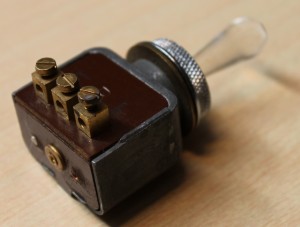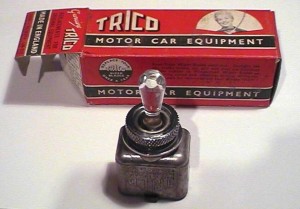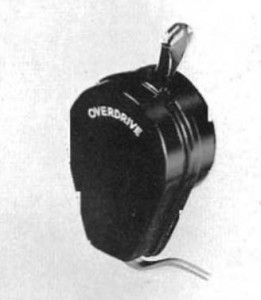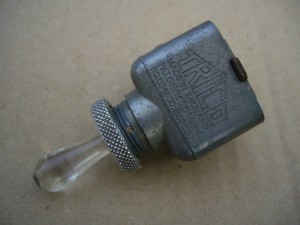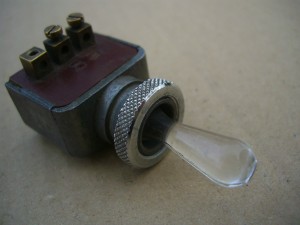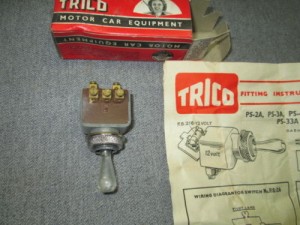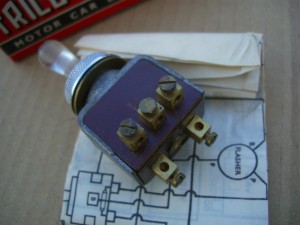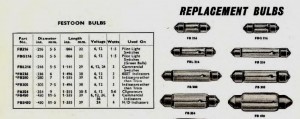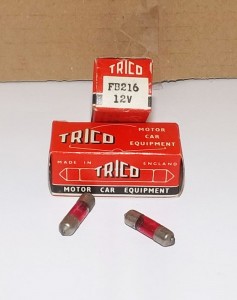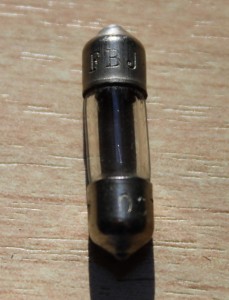Category Archives: 06. Gearbox
Conversion Trico switch PS-33A to PS-4A
Conversion Trico switch PS-33A (3 positions) to Trico PS-4A (2 positions)
Trico manufactured different switches for automotive applications. Although they look very similar, there is a distinct difference in their functionality.
The Trico PS-33A switch was used as a direction indicator switch with 3 positions: left, off and right. This switch was used by a number of British car manufacturers and can sometimes still be found in NOS condition.
Jaguar used the Trico PS-4A switch as an overdrive switch from 1955 till the early Sixties. It is a two-position switch (on/off) but in fact largely identical to the aforementioned PS-33A as the internals of the switch are common.
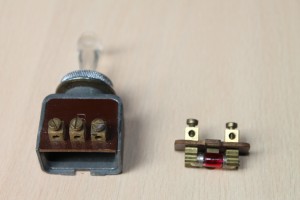 Trico PS-33A
Trico PS-33A
The difference is that the warning light inside the switch has internal connections in case of the PS-4A, whereas the PS-33A has additional connectors on the bottom plate (which carries the warning light) but the correct internal connections for the warning light are missing. The way Trico made a two position switch from a three position is simply done by blocking the third position by using a rubber buffer that prevents the handle to move.
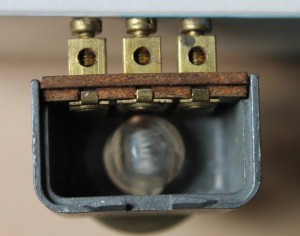
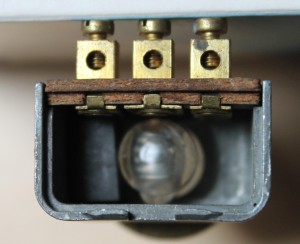 A rubber buffer is placed in the housing of the PS-33A to convert it to a 2-position switch
A rubber buffer is placed in the housing of the PS-33A to convert it to a 2-position switch
The PS-33A has only the letter B (for battery) positioned as an indication for the centre one of the three connectors on the phenolic back plate. It is easier to mark the other two contacts with E (for earth) and L (for “load” which in case of Jaguar is the solenoid of the overdrive).
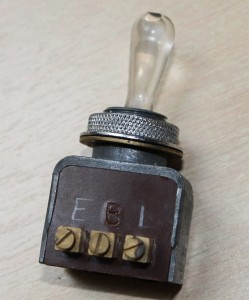 Marks for E and L in addition to the existing B
Marks for E and L in addition to the existing B
The conversions requires two modifications of the PS-33A switch:
1. After the bottom cover has been carefully removed it is possible to slide down the back wall of the switch. Beware of the ball that will jump out because of the spring behind it (see photo below right). A (semi-hard) rubber buffer of 12.7 x 10 x 7.0 mm is now placed (and preferably glued) in the aluminium housing at the side where the mark E has been put. This is done to block the third position. The 7.0 mm dimension is important and should be correct in order to allow the handle to rest in the centre position but not reach the third position.
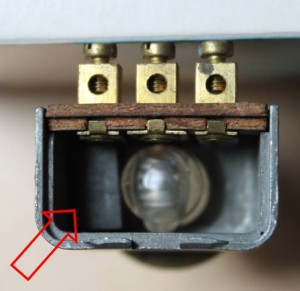
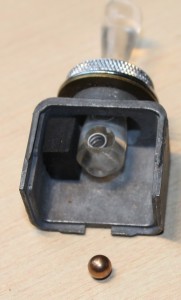 Rubber positioned
Rubber positioned
2. The warning light inside the PS-33A switch has two contacts. As the PS-4A has internal electrical connections, for the conversion external electrical connections have to be made to contacts E and L. The third contact B has an internal connection in case of the PS-33A but will not be used. There are two possibilities for making the electrical connections:
a. Simply connect the existing LH contact on the bottom plate to the E terminal of the back plate and the RH contact to the L terminal.
b. In case one would the PS-33A switch to look more like the PS-4A on the outside, then first remove the bottom plate and slide away the back plate (see photo above right). It is possible to (carefully!) remove the existing brass terminals on the bottom plate by pulling them out of the rivited brass connection. Then take two thin wires and solder them to the lamp contacts at each end of the bulb and connect one to the E and the other to the L connector on the inside of the switch.
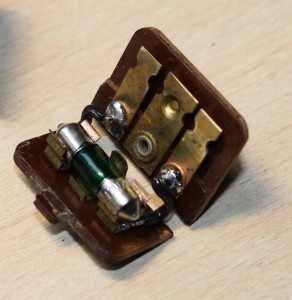 Internal connection made by soldering
Internal connection made by soldering
The photo below shows the final result of the conversion (left) and an original PS-4A (right) for comparison.
Trico illuminated (overdrive) switch
Trico illuminated switches
Besides the well-known vacuum equipment for wipers and washers, Trico also manufactured a large variety of switches as part of their programme for the automotive industry. One of the most “famous” versions is the PS (Pilot light Switch) range with an illuminated, transparent handle. This is a specific UK developed and manufactured product.
Switches have been supplied during the 1950s and 1960s after which production in the UK ceased.
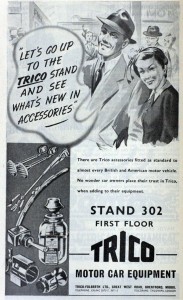 1951 advertisement with Trico PS type of switch
1951 advertisement with Trico PS type of switch
The Trico PS (Pilot light Switch) range.
The range consisted of at least 7 versions (but possibly more), each one intended for a specific application like:
- 2 or 3 positions (1 way or 2 way switch)
- specific load to be switched
- which signalling function required
- required bulb colour
- 6 Volt or 12 Volt execution
The switch is to be mounted in a panel using a ⅝” or 16 mm hole. A chromed knurled ring, acting as nut, secures the switch to the panel.
 Survey of PS switches
Survey of PS switches
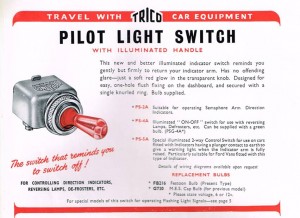 Catalogue 1953 (courtesy Roger Payne)
Catalogue 1953 (courtesy Roger Payne)
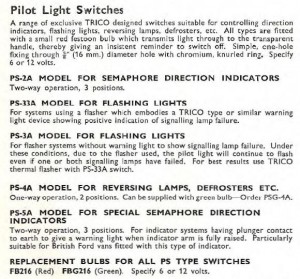
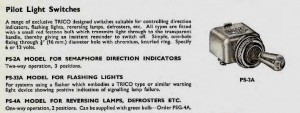 Catalogue 1959 Catalogue 1960
Catalogue 1959 Catalogue 1960
The PS switch construction
All switches used the same aluminium die cast housing, suitable for 3 positions. The signal lamp was positioned on a (thermoset) plastic cover at the bottom of the switch, whereby the number and position of contacts depended on the signalling function.
In case of a 2 position switch a rubber buffer was placed at one side within the aluminium housing blocking the 3rd position.
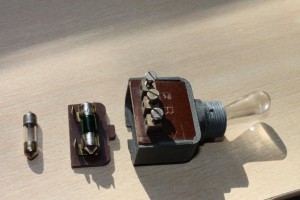 Typical construction
Typical construction
Jaguar application of the PSG-4A switch
Although Lucas recommended their manual overdrive switch type 9RW (Lucas part number 31587 or 031648) in combination with Laycock overdrives, Jaguar instead opted for a Trico switch in spite of the very close relation with their “preferred supplier”.
Lucas overdrive switch 9RW used on Armstrong Siddeley and Triumph
In 1954 Jaguar introduced the PSG-4A as an overdrive switch on the XK140 (and other contemporary models like the Jaguar Mk VIIM and Jaguar Mk1) with Jaguar part number C7474. This switch had 3 screw terminals of which two were marked: the middle had the letter B (battery) and the other with the letter E (earthing the signal bulb). The third (unmarked) contact is connected to the Overdrive Relay(s). This switch originally had a green “festoon” bulb (although many may have received a white replacement bulb in the past decades). The replacement Trico bulb FBG216 received Jaguar part number C8829.
Note that the PS-4A version is normally supplied with a red bulb, but Jaguar opted for the green bulb.
Note: For the XK150 Jaguar changed over to part number C12832 (81053 JSB) which is not further discussed here. Also the Mk2 used a different (Lucas) switch type 52SA with Jaguar part number C15611 (Lucas part number 31965A) followed by SA52 type switch with part number C23391 (Lucas 34804).
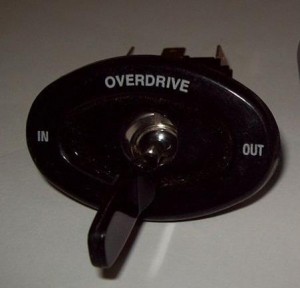
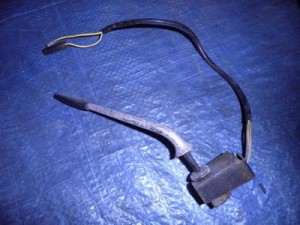
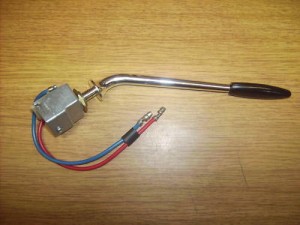 C12832 C15611 C23391
C12832 C15611 C23391
Examples of other Trico PS switches
The PS-33A is used as a direction indicator switch. It has additional screw terminals for the festoon bulb at the bottom of the switch. It is not a direct replacement for the Overdrive switch PSG-4A.
 Complete box with 6 pcs Trico PS-33A
Complete box with 6 pcs Trico PS-33A
Trico “Festoon” bulbs
The bulb was of the “festoon” type and was supplied by Trico. There are 2 known bulb colours: red and green. The Trico part number for the built-in indicator bulb is FB216, which is a 12V 1.5W festoon green bulb of 22 mm length. Trico provided a large range of “festoon” bulbs: only the FB216 version was correct for the PS switches.
Green replacement bulbs are very hard to find. In Germany a similar bulb type is coded S6 (6 x 24 mm) 12 volt available in either 1.2 W or 2.0 W with S5.5 bulb contacts. The standard diameter of the original Trico bulb is 0.216” or 5.5 mm so the S6 version will fit. Sometimes available in green but 2W instead of 1.5 W (e.g. Scharnberger 25929).
